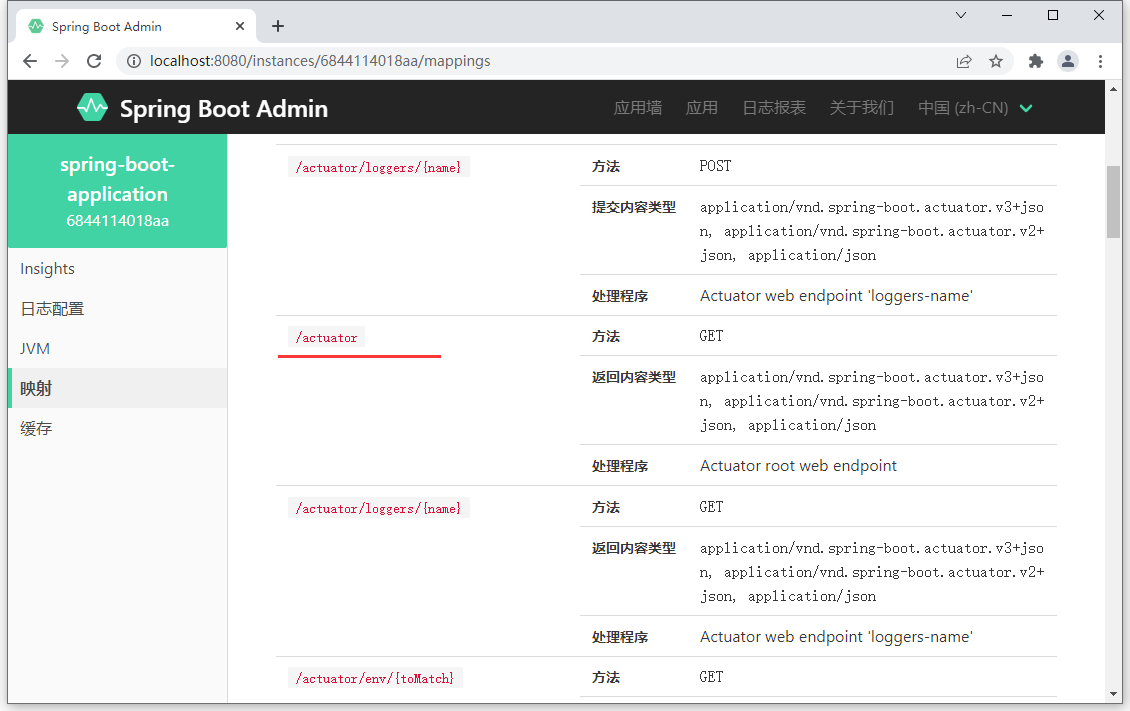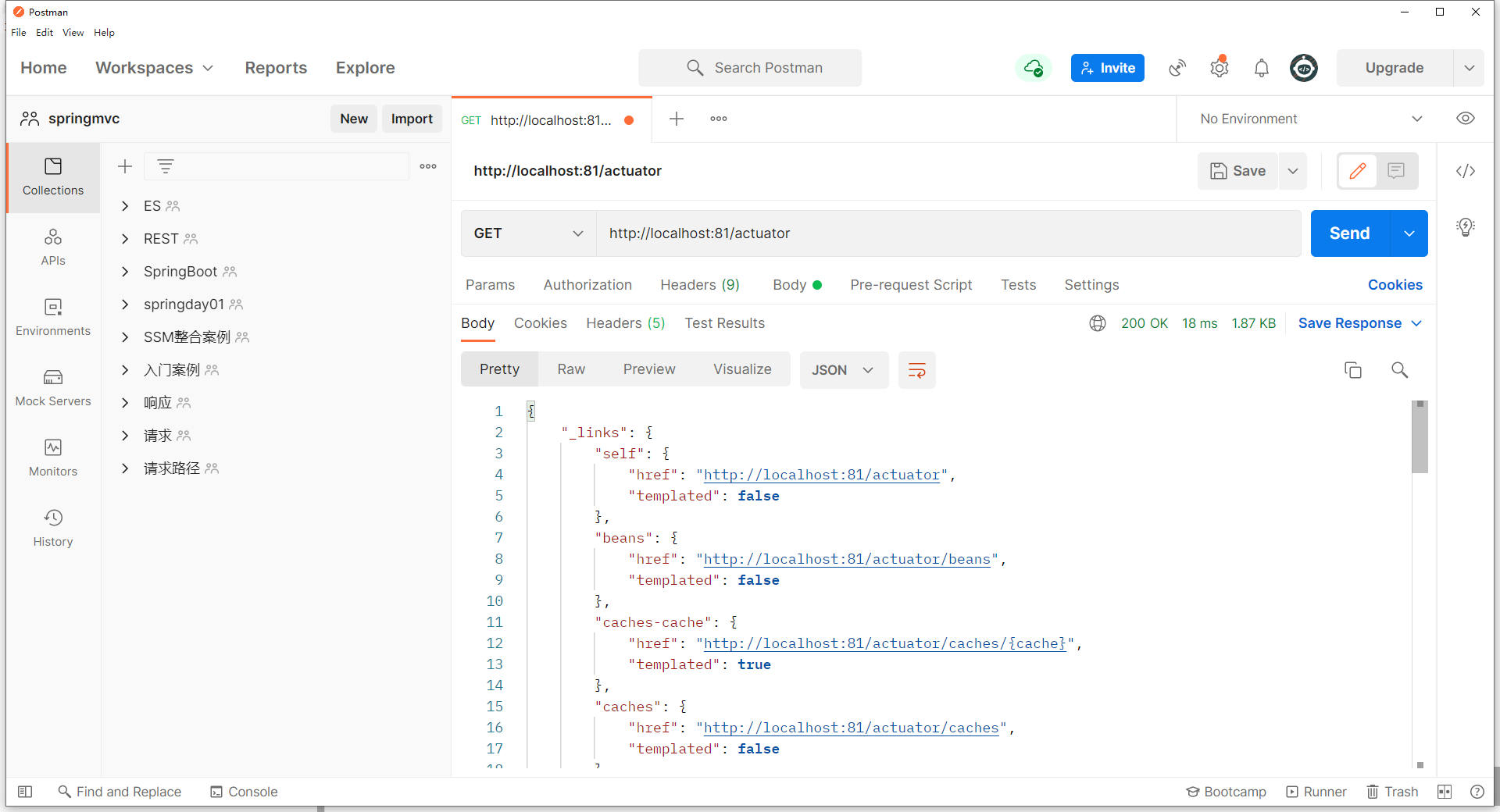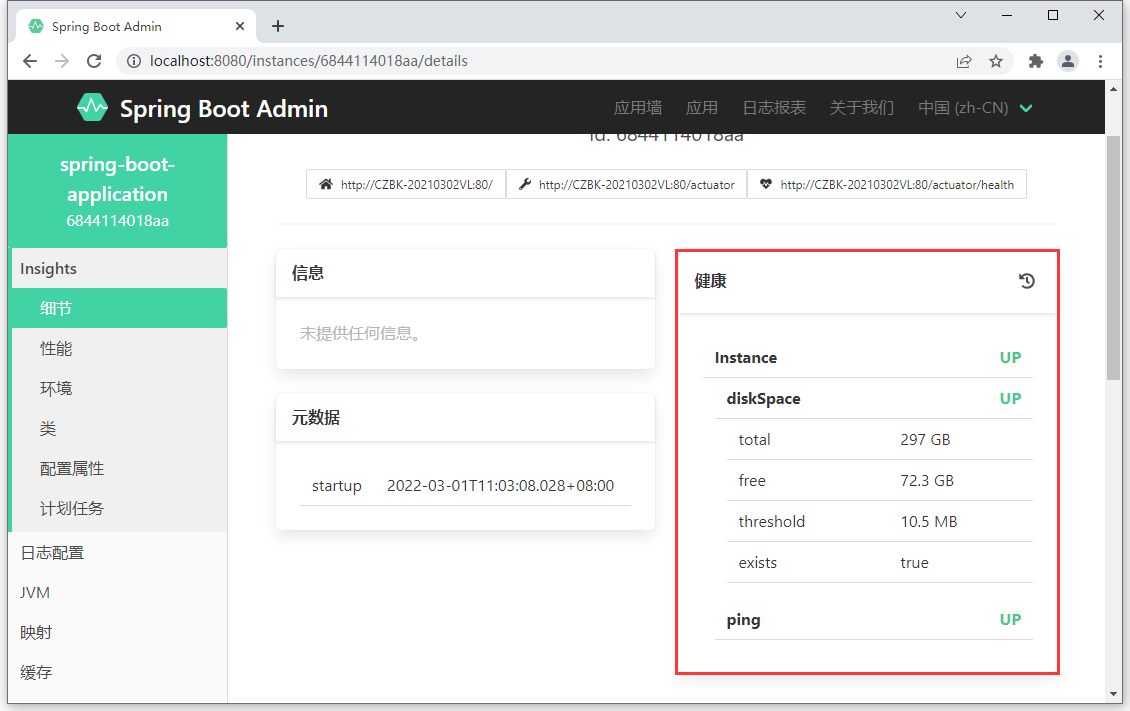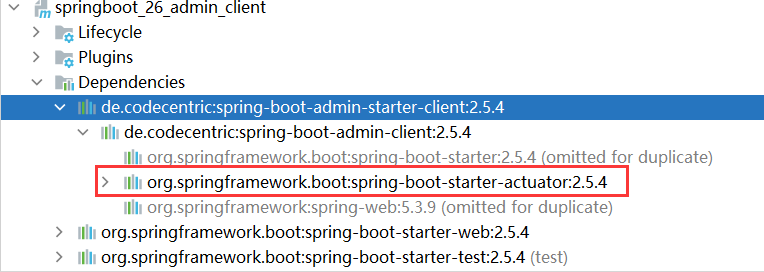通过查阅监控中的映射指标,可以看到当前系统中可以运行的所有请求路径,其中大部分路径以/actuator开头

首先这些请求路径不是开发者自己编写的,其次这个路径代表什么含义呢?既然这个路径可以访问,就可以通过浏览器发送该请求看看究竟可以得到什么信息。

通过发送请求,可以得到一组json信息,如下
{
"_links": {
"self": {
"href": "http://localhost:81/actuator",
"templated": false
},
"beans": {
"href": "http://localhost:81/actuator/beans",
"templated": false
},
"caches-cache": {
"href": "http://localhost:81/actuator/caches/{cache}",
"templated": true
},
"caches": {
"href": "http://localhost:81/actuator/caches",
"templated": false
},
"health": {
"href": "http://localhost:81/actuator/health",
"templated": false
},
"health-path": {
"href": "http://localhost:81/actuator/health/{*path}",
"templated": true
},
"info": {
"href": "http://localhost:81/actuator/info",
"templated": false
},
"conditions": {
"href": "http://localhost:81/actuator/conditions",
"templated": false
},
"shutdown": {
"href": "http://localhost:81/actuator/shutdown",
"templated": false
},
"configprops": {
"href": "http://localhost:81/actuator/configprops",
"templated": false
},
"configprops-prefix": {
"href": "http://localhost:81/actuator/configprops/{prefix}",
"templated": true
},
"env": {
"href": "http://localhost:81/actuator/env",
"templated": false
},
"env-toMatch": {
"href": "http://localhost:81/actuator/env/{toMatch}",
"templated": true
},
"loggers": {
"href": "http://localhost:81/actuator/loggers",
"templated": false
},
"loggers-name": {
"href": "http://localhost:81/actuator/loggers/{name}",
"templated": true
},
"heapdump": {
"href": "http://localhost:81/actuator/heapdump",
"templated": false
},
"threaddump": {
"href": "http://localhost:81/actuator/threaddump",
"templated": false
},
"metrics-requiredMetricName": {
"href": "http://localhost:81/actuator/metrics/{requiredMetricName}",
"templated": true
},
"metrics": {
"href": "http://localhost:81/actuator/metrics",
"templated": false
},
"scheduledtasks": {
"href": "http://localhost:81/actuator/scheduledtasks",
"templated": false
},
"mappings": {
"href": "http://localhost:81/actuator/mappings",
"templated": false
}
}
} 其中每一组数据都有一个请求路径,而在这里请求路径中有之前看到过的health,发送此请求又得到了一组信息
{
"status": "UP",
"components": {
"diskSpace": {
"status": "UP",
"details": {
"total": 297042808832,
"free": 72284409856,
"threshold": 10485760,
"exists": true
}
},
"ping": {
"status": "UP"
}
}
}当前信息与监控面板中的数据存在着对应关系

原来监控中显示的信息实际上是通过发送请求后得到json数据,然后展示出来。按照上述操作,可以发送更多的以/actuator开头的链接地址,获取更多的数据,这些数据汇总到一起组成了监控平台显示的所有数据。
到这里我们得到了一个核心信息,监控平台中显示的信息实际上是通过对被监控的应用发送请求得到的。那这些请求谁开发的呢?打开被监控应用的pom文件,其中导入了springboot admin的对应的client,在这个资源中导入了一个名称叫做actuator的包。被监控的应用之所以可以对外提供上述请求路径,就是因为添加了这个包。

这个actuator是什么呢?这就是本节要讲的核心内容,监控的端点。
Actuator,可以称为端点,描述了一组监控信息,SpringBootAdmin提供了多个内置端点,通过访问端点就可以获取对应的监控信息,也可以根据需要自定义端点信息。通过发送请求路劲**/actuator可以访问应用所有端点信息,如果端点中还有明细信息可以发送请求/actuator/端点名称**来获取详细信息。以下列出了所有端点信息说明:
ID |
描述 |
默认启用 |
|---|---|---|
auditevents |
暴露当前应用程序的审计事件信息。 |
是 |
beans |
显示应用程序中所有 Spring bean 的完整列表。 |
是 |
caches |
暴露可用的缓存。 |
是 |
conditions |
显示在配置和自动配置类上评估的条件以及它们匹配或不匹配的原因。 |
是 |
configprops |
显示所有 @ConfigurationProperties 的校对清单。 |
是 |
env |
暴露 Spring ConfigurableEnvironment 中的属性。 |
是 |
flyway |
显示已应用的 Flyway 数据库迁移。 |
是 |
health |
显示应用程序健康信息 |
是 |
httptrace |
显示 HTTP 追踪信息(默认情况下,最后 100 个 HTTP 请求/响应交换)。 |
是 |
info |
显示应用程序信息。 |
是 |
integrationgraph |
显示 Spring Integration 图。 |
是 |
loggers |
显示和修改应用程序中日志记录器的配置。 |
是 |
liquibase |
显示已应用的 Liquibase 数据库迁移。 |
是 |
metrics |
显示当前应用程序的指标度量信息。 |
是 |
mappings |
显示所有 @RequestMapping 路径的整理清单。 |
是 |
scheduledtasks |
显示应用程序中的调度任务。 |
是 |
sessions |
允许从 Spring Session 支持的会话存储中检索和删除用户会话。当使用 Spring Session 的响应式 Web 应用程序支持时不可用。 |
是 |
shutdown |
正常关闭应用程序。 |
否 |
threaddump |
执行线程 dump。 |
是 |
heapdump |
返回一个 hprof 堆 dump 文件。 |
是 |
jolokia |
通过 HTTP 暴露 JMX bean(当 Jolokia 在 classpath 上时,不适用于 WebFlux)。 |
是 |
logfile |
返回日志文件的内容(如果已设置 logging.file 或 logging.path 属性)。支持使用 HTTP Range 头来检索部分日志文件的内容。 |
是 |
prometheus |
以可以由 Prometheus 服务器抓取的格式暴露指标。 |
是 |
上述端点每一项代表被监控的指标,如果对外开放则监控平台可以查询到对应的端点信息,如果未开放则无法查询对应的端点信息。通过配置可以设置端点是否对外开放功能。使用enable属性控制端点是否对外开放。其中health端点为默认端点,不能关闭。
management:
endpoint:
health: # 端点名称
show-details: always
info: # 端点名称
enabled: true # 是否开放为了方便开发者快速配置端点,springboot admin设置了13个较为常用的端点作为默认开放的端点,如果需要控制默认开放的端点的开放状态,可以通过配置设置,如下:
management:
endpoints:
enabled-by-default: true # 是否开启默认端点,默认值true上述端点开启后,就可以通过端点对应的路径查看对应的信息了。但是此时还不能通过HTTP请求查询此信息,还需要开启通过HTTP请求查询的端点名称,使用“*”可以简化配置成开放所有端点的WEB端HTTP请求权限。
management:
endpoints:
web:
exposure:
include: "*"整体上来说,对于端点的配置有两组信息,一组是endpoints开头的,对所有端点进行配置,一组是endpoint开头的,对具体端点进行配置。
management:
endpoint: # 具体端点的配置
health:
show-details: always
info:
enabled: true
endpoints: # 全部端点的配置
web:
exposure:
include: "*"
enabled-by-default: true总结
被监控客户端通过添加actuator的坐标可以对外提供被访问的端点功能
端点功能的开放与关闭可以通过配置进行控制
web端默认无法获取所有端点信息,通过配置开放端点功能
